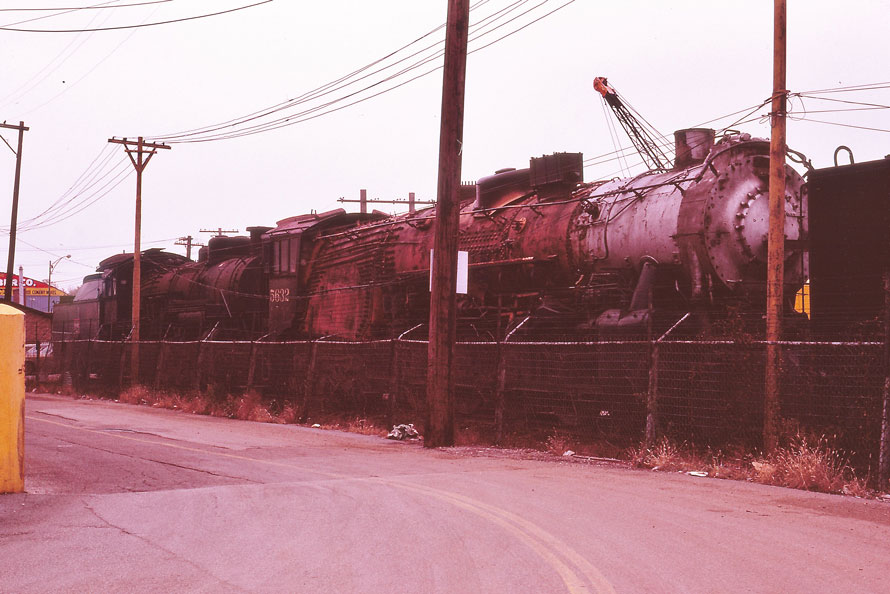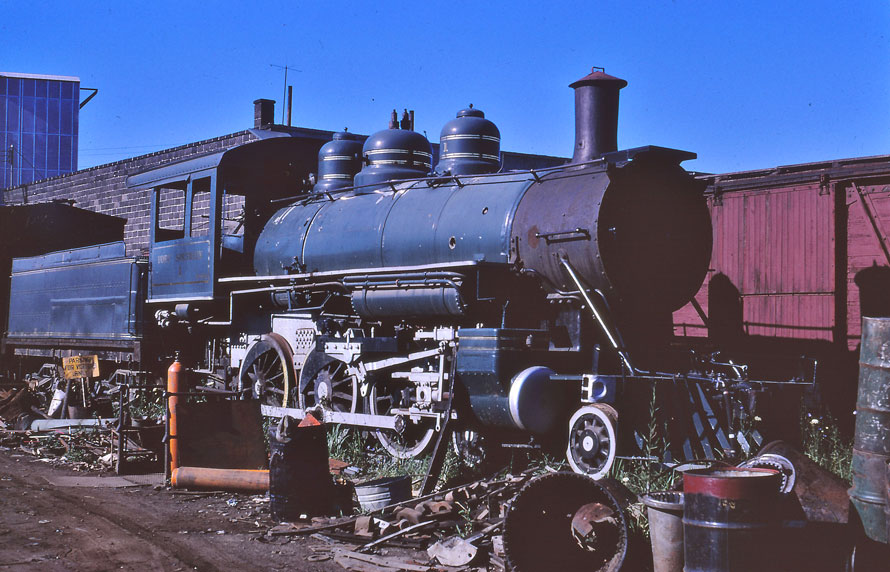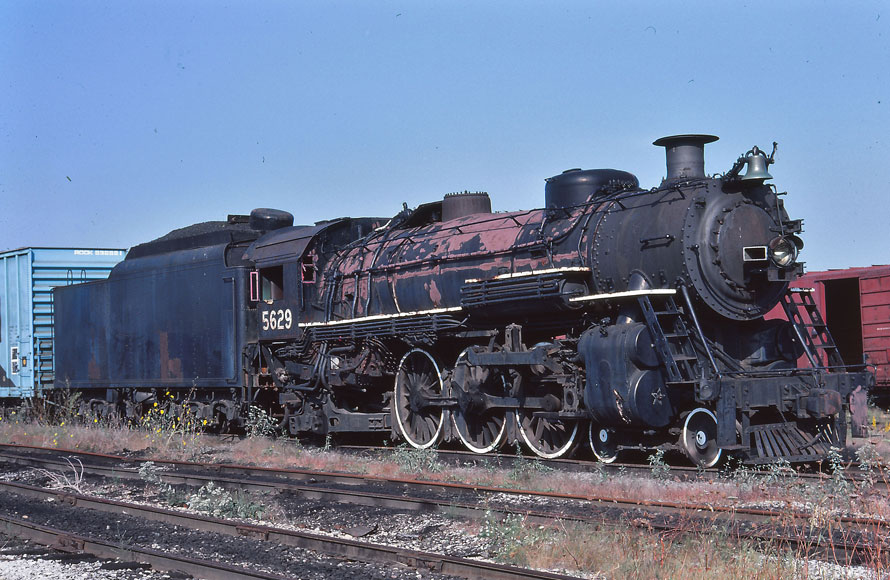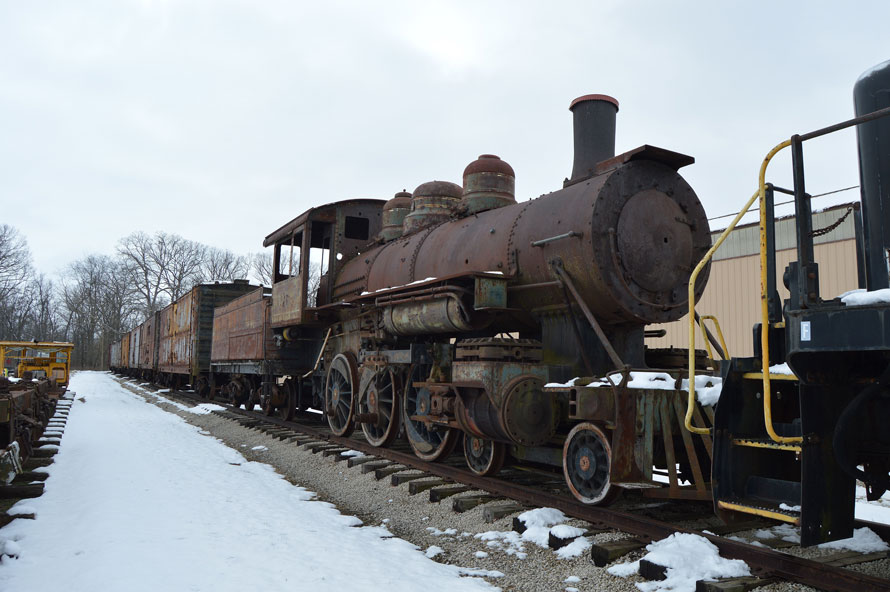Part Two
The Beginning of the End
In 1968, Robert McMillan left the Chicago & Western Indiana. The new owners of the C&WI wanted to demolish the 47th Street Roundhouse due to the building falling into disrepair, so with no warning, on February 27, 1969, Dick Jensen received a notice that he had 30 days to vacate the property. Negotiations with the C&WI extended the deadline to June 1. Panicking, the Midwest Steam Railfan’s Association quickly removed everything they could from the roundhouse. Lots of the little things were loaded into Dick’s bread delivery truck and stored at his home in Forest Park, Illinois.
With no place to relocate the two disassembled CB&Q locomotives to, Dick and his crew desperately searched for a new storage site, even if it was temporary. At one point, there were ongoing discussions of bringing the 4963 and 5632 to the Illinois Railway Museum in Union, Illinois, but for reasons unknown, the plan never materialized, and the two engines remained in the roundhouse. (At the time, the 5629 was being stored in Detroit for excursion use there and besides some spare parts that Dick had kept in the roundhouse, it was uninvolved with this.)
On September 25, 1969, the C&WI unexpectedly (and later proved illegally) sold the 4963 and 5632 along with the cars full of tools and parts to the Erman-Howell Division of the Luria Brothers Scrap Company for $5,800. Dick Jensen, desperate to try and save his engines, offered to buy them from Luria Brothers for their scrap value but his offer was rejected. The two locomotives were moved in a special train to the scrapyard, and placed into storage. In November of 1972, the 5632 was relocated in the yard, and in the process derailed on a switch. Not wanting to perform the herculean task of re-railing the gigantic locomotive, Erman-Howell torched it where it sat, and the remains were soon trucked away to be melted down.

As soon as he found out what happened to the 5632, an infuriated Dick Jensen filed a lawsuit against the C&WI and Erman-Howell in early 1973. Several court sessions followed, including one where Erman-Howell was required to bring in all of the locomotive parts stored in Dick’s boxcars and baggage car for the jury to view, including a 1,500-pound side rod from Georgia & Northern 102 that was displayed in the courthouse basement. After a lengthy battle, the C&WI offered to pay Dick the scrap value of what was lost, which was approximately $6,000. Dick declined and asked for more. The C&WI then raised their offer to $150,000, but he again declined. After eight years of negotiations, in 1981, the court finally ruled that Erman-Howell and the C&WI had to pay Dick approximately $1.7 million, however, for various reasons he never saw the full amount.
Despite all the trouble, Dick continued to acquire new things for his collection. In 1970, he purchased another 4-6-0, York Southern No. 1 (serial 43334), built by Baldwin in 1916, from a scrapyard in York, Pennsylvania. The troubled locomotive had worked on several railroads in the southeast before being purchased by Byron Andrews in the late 1960s for use on a tourist railroad in York that never got beyond running a couple of excursions behind diesels. It was sold to a scrapper in a sheriff auction following Byron falling thousands of dollars behind on rent for its storage site. After Dick bought it, the aging Baldwin was moved on its own wheels dead-in-tow on freight trains to Chicago, where it was placed in storage along the Chicago West Pullman & Southern Railroad.

In April of 1971, another GTW 5629 trip over the newly formed Penn Central was planned, but after issues with getting passenger cars for the trip, it was cancelled. Dick Jensen was also in financial trouble following the legal issues, and many people who bought tickets for the ill-fated PC trip would never see their money again despite being promised a refund. This became such a big problem that in a February 1974 newspaper, a large section of a page was devoted to an angry ticket holder who wrote about Dick Jensen ripping him off. The paper contacted Dick on the writer’s behalf, and he responded, “Oh yeah, there are still some people who didn’t get their money back. They’ll just have to wait ‘til I get around to it.” In all likelihood, the passenger who contacted the paper never got his refund.
In the early 1970s, multiple organizations were sponsoring and operating so many steam trips with other locomotives over the GTW and other railroads out of Chicago that Dick Jensen began having a hard time keeping up with the competition. While the 5629 was still loved by many, ticket sales were declining as passengers chose to ride other trips with other locomotives instead. Several popular trips over the GTW behind Canadian National No. 6218 were especially hard on Dick’s operation.
In addition to declining ridership, new railroad management that were not as open to running steam excursions as in earlier times were making trips more difficult to put together. Following the loss of two of his locomotives and his shop facility, combined with the previously mentioned challenges, Dick Jensen was quickly losing interest in running steam excursions. The 5629 ran what is believed to be its final excursion trip in the spring of 1973. It is unknown, at least to this author, if any more trips happened after that. By early 1974, the 5629 was in storage, never to pull an excursion again.
In 1975, Dick was hired to go to Fort Worth, Texas to restore Texas & Pacific No. 610 for use on the American Freedom Train. Under his direction, the project ran way behind schedule and the group in charge of the project fired and replaced him. A couple years after returning to Chicago, a friend needed Dick’s help moving a new refrigerator up to a third-floor apartment. During the move, Dick slipped and fell down several flights of stairs, ending up seriously injured. Hospitalized for several weeks, Dick fell into even more financial trouble and could not afford to pay rent for the places where he stored his equipment.
Meanwhile, the 5629 was being stored at the Penn Central/Amtrak yard near Union Station in Chicago. Also behind on rent there, Dick began searching for a new place to store it. He went to several railroads in Chicago to ask if they would store it for him; all of them said no. Frustrated and desperate, Dick traveled to the Chicago South Shore & South Bend Railroad’s offices and was almost thrown off the property after demanding that they store the 5629. As a last resort, Dick approached the bankrupt Rock Island, who, in desperate need of funds, allowed him to store the locomotive at their deteriorating roundhouse in Blue Island, Illinois. However, it was reported that Dick Jensen never paid rent once, and eventually wound up owing hundreds of thousands of dollars.
At the roundhouse, the 5629 was separated from its tender and they were stored side by side in different stalls while the building slowly caved in around them. Around 1979, the Rock Island asked Dick to move the locomotive out of the roundhouse so it could be demolished, and sometime in that year it was reunited with the tender and moved elsewhere in the yard. Little did anyone know that the 5629 would never move again.
In 1981, the Chicago West Pullman & Southern gave up trying to collect rent from Dick. They sold York Southern No. 1 and two former Illinois Central tenders that were also owned by Dick (it is believed that these two tenders were eventually going to be used on the 4963 and 5632) at auction to William Latham of Rockford, Illinois, who planned to create a small railroad museum. When this plan fell through, No. 1 was donated to the Monticello Railway Museum of Monticello, Illinois and the two IC tenders were scrapped.
The Loss of a Star

The Rock Island shut down on March 31, 1980 following years of bankruptcy. The Blue Island property was sold to Metra Commuter Rail, who started planning for a new shop complex to be built at the site. Once the redevelopment plans were finalized, Metra asked Dick to move the 5629 to make way for a new car shop, and informed him that they would not assist with moving it. Dick went to prepare the locomotive for movement, but discovered that many critical moving parts had been stolen or damaged during its time stored in Blue Island.
It was around this time that Dick began thinking that if he did not do anything to move his engine, and it was scrapped, he could file another lawsuit and win another million dollars. He was in a good place to do it–the 5629 was already in deep water. The vandalism done to the locomotive over the years had rendered it immovable, the track in front of the locomotive had been removed which landlocked it, and the only way to remove it from the property was by truck, something that he could not afford. In addition, he had not paid rent at all since Metra took over, and Metra was getting extremely frustrated. Dick removed additional important moving parts off the engine and tender through 1985.
One of the common misunderstandings about this story is that Metra wanted the locomotive to be scrapped and was against preserving old railroad equipment, but that is certainly not the case. Chris Knapton, a spokesman for Metra, told news reporters that they were just as sad to see the 5629 in the situation it was in as everyone else was. He noted that Metra had recently donated two historic interurban cars to the Fox River Trolley Museum of South Elgin, Illinois. “So as far as having a hard-boiled attitude towards historic objects, Metra should not be accused of that,” he said.
Knapton also noted how Dick Jensen’s unwillingness to work with Metra or repair the locomotive was the main cause of the problem. “We started sending him bills and he never sent us a nickel,” he explained, “It’s a hunk of rust. It’s really sad the way he let it deteriorate.”
In late 1986, Metra had enough and went to court. The ruling was that if Dick did not find a way to remove it from Metra’s property, it would have to be destroyed. “All Metra wants is the engine off our land,” explained Chris Knapton, “and since it (can’t be moved), the only alternative is to cut it up.”
In May, 1987, the Illinois Railway Museum offered to purchase the 5629 from Dick for its $15,000 scrap value, but Dick declined. A subsequent offer from the Mid-Continent Railway Museum of North Freedom, Wisconsin was also declined. At one point, Metra went back to court requesting permission to seize the 5629 and donate it to a museum that could remove it from their property, but the court said that it belonged to Dick Jensen and they could not legally claim ownership. By June, 1987, Dick had been banned from entering Metra’s property to access the 5629, as he was removing countless parts from the engine and tender and selling them to local railfans, so much so that Metra feared the 5629 was going to become a safety hazard.
On July 1, 1987, a relieved Metra, albeit sad to see the 5629 go, received a court order to scrap it. Dick Jensen appealed the order. It is unknown what his intention was here; perhaps he had a change of heart and wanted the locomotive to be saved. However, the most likely reason is that he wanted to use the appeal to assist with the lawsuit he was going to file after the engine had been scrapped. On July 10, the court declined his appeal, and Metra contracted with Erman-Howell to dispose of the 5629.
On July 13, an Erman-Howell employee began test cutting the boiler from underneath the locomotive. Scrapping began the next day. Railfans from around Chicagoland came to Blue Island to say goodbye to the locomotive that had delighted thousands of people for the last 27 years. So many people showed up that Metra police officers had to start kicking people off of the property. They also confiscated the film out of cameras of trespassing photographers, so photographs of the scrapping are extremely rare. By July 20, the remains of the 5629 had been loaded into trucks and hauled away. Coincidentally, just a year prior on July 20, 1986, the 5629’s longtime engineer Bud Young passed away at age 79.
After the scrapping, Metra discovered that much of the vandalism done to the 5629 prior to the legal battle had been done by Metra employees. A thorough investigation followed, and several employees were dismissed in 1988 and 1989.
As expected, Dick filed a lawsuit against Metra and requested money to compensate for the locomotive. However, this time, the court did not rule in his favor. After that, Dick Jensen, in poor health from his accident and now disliked by many people for letting the 5629 get scrapped, slowly faded out of the railfan scene. In March of 1991, he was hospitalized again, and passed away on the 16th at age 59.
Dick’s sister, Rita Wied, was put in charge of selling off what remained of his collection and taking care of all the financial and legal issues that he left behind. After selling the last few items, Rita moved to Fort Lauderdale, Florida. One of the last items that she was unable to sell before moving was surprisingly the bell of the 5629 that had been removed just prior to the scrapping for safekeeping. It has since wound up in a Chicago-area railfan’s private collection.
Shortly after Dick’s death, a member of the Illinois Railway Museum discovered the derelict Georgia & Northern 102 still sitting on a flatcar in Chicago where it had been since 1965, minus side rods and other small parts that Dick removed years before. A scrapper with a torch ready to begin cutting was approaching the locomotive. The museum member quickly stopped the scrapper and demanded that he wait so IRM could see if they could get their hands on it. After a few frantic phone calls, it was discovered that Dick Jensen owed over $5,000 in rent to the property owner who wanted the locomotive gone so he could redevelop the land. The Illinois Railway Museum ended up paying the $5,000 to the property owner and made a deal with Rita to have the locomotive donated to IRM. Talk about a last minute save! IRM would eventually sell the 102 to the End-O-Line Railroad Park in Currie, Minnesota where it remains today.
In late 1991, CB&Q No. 4963, sitting in the same spot it had been in since 1969, was also about to be scrapped. A proposition was made to the City of Chicago to acquire the locomotive and run their own steam excursions around the city. When this effort failed, the threat of scrapping returned. Fearing a repeat of the 5629, the Illinois Railway Museum traded five former GTW 0-8-0s it had recently acquired from the Northwestern Steel & Wire Company of Sterling, Illinois in exchange for the 4963. Today, the venerable 2-8-2 is displayed at IRM and is undergoing a slow cosmetic restoration.
Postscript
As time moves on, the story of Dick Jensen is slowly fading into history. Former friends, volunteers, and passengers have passed away and today only a handful are left. The lack of accurate information available to the public has caused rumors and inaccurate information to spread. What was left of Dick’s collection is scattered around the country, and besides the surviving locomotives, the collection is likely never to be seen by the public again. Old photographs, slides, and negatives pop up for sale here and there, but they too are becoming scarce. Even the Illinois Railway Museum skipped mentioning Dick on the plaque that’s mounted on the 4963 explaining its history. It is my hope that this article will not only help tell the full, true story, but also renew interest in this dying subject.
On one of my recent visits to the Monticello Railway Museum, I paid a visit to York Southern No. 1. The museum has had it in storage in the back of their yard since its arrival from William Latham’s property in June of 2000. It’s in a very sad state today. Suffering from being covered coupler to coupler in rust, scale, and rotting wood, a broken tender coupler, and missing parts everywhere, it is highly unlikely that the locomotive will ever run again. A cosmetic restoration is planned, but it may be quite some time before work begins.

Much to my surprise, a small “Save–RJ” soapstone marking was peeking through the rust on the side of the pilot. It made me think about everything that the locomotive had seen over the years–the hundreds of journeys it made through the southeast, the trip to York, the hope that it would see a new life, and the disappointment when it didn’t. I thought about the sheriff auction, the sale to Dick Jensen, and the second sale to William Latham.
About this time, a museum volunteer came up to me and said “She’s in rough shape, but we’ll get ‘er into the shop eventually.” I happily walked away, knowing that this unfortunate locomotive’s story will have a happy ending–something that didn’t seem likely a couple decades ago. MRM’s dedicated restoration team will finish a project that Byron Andrews started and Dick Jensen continued. I wonder if they will think about the same things I thought of when they find that “Save–RJ” marking.
I have a feeling they will.
Thomas Dyrek – Photographs and text Copyright 2021
This is the second part of a two part article. Click here to read Part One
Thank you for setting the record straight. Railway preservation is far more complex and difficult than most people realize, and sometimes the best of intentions don’t lead to good outcomes.
Jensen walked a tightrope between legitimacy and hope. His intensions were noble, even if his methods were suspect and at times just a bit iffy.
BTW, there is no “&” between Georgia Northern. The Georgia Northern Railway (which ironically was located in deep SOUTH GA. ) was eventually folded into the Southern Railway system.
The story on steamlocomotive.com says that those two Illinois Central tenders were numbered 2612 and 2613(the latter was also a torched mainline steam star). Not only that, but Jensen also bought two spare Rock Island tenders, one of which would later become an auxiliary tender for Pere Marquette 1225. Is any of this true?
I have not been able to confirm whether or not the Rock Island tenders were owned by Dick. The IC tenders did indeed come from the 2612 and 2613; a member of the Monticello Railway Museum attempted to save one from William Latham’s failed museum in Rockford, but that effort fell through and both were scrapped circa 2011.
I have doubts, whether this is entirely accurate on the story of 5629. From what I’ve read from first hand accounts. It was Metra who threatened Jensen with removal or scrapping. Unless he turns it over to their ownership. Metra employees with an agenda vandalised and removed the bearings to prevent the loco from moving. Jensen had ask the IAS for the movement, but Metra wouldn’t allow them to inspect or even be anywhere near the engine. A judge ruled that the engien had to be moved by any means necessary. But then Metra scrapped it as a cover up for their vandalism and reduce its value. And the shopping complex was never built, as it turned out to be a scam. One of many Metra was involved in. Metra then sued Jensen over the engine which wasn’t even under their ownership or legal control.
I don’t think 5629 last ran in 1973. I understand you think so, thanks to rrpicturearchives, but if you look look closely at that photo of 5629 that was “labeled” 1973, it kind of looks more like it took place in 1968, judging by the coaches it pulled there. And if you look closely at those photos of when she was taken in 1972 and 1974, although her numberplate and sand dome were removed in the latter, the coal loads and the valve gear positions look like they match. I guess all I’m getting at is that I don’t think 5629 ever hauled an excursion after that ill-fated Penn Central trip got canned.